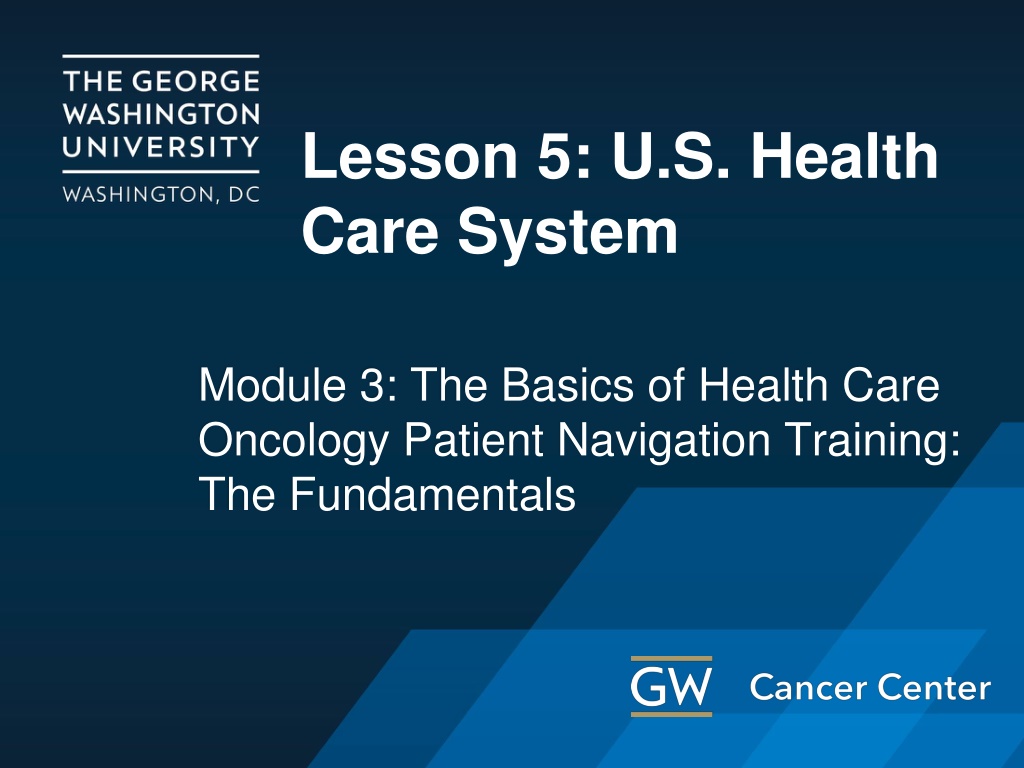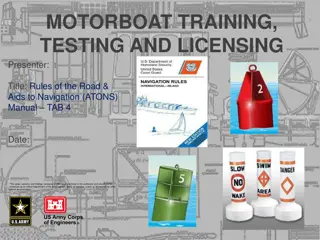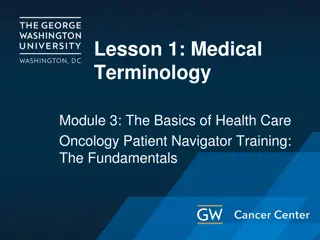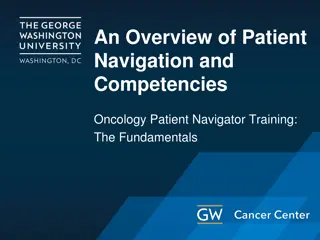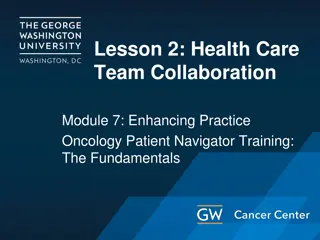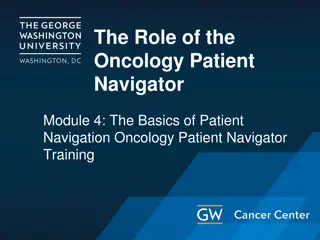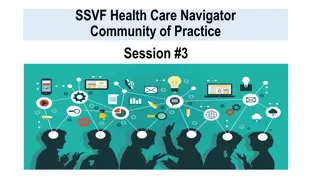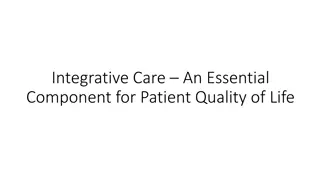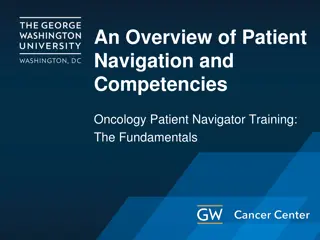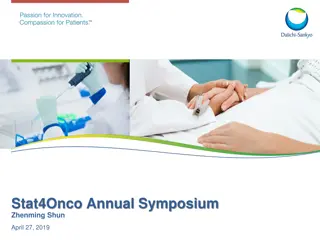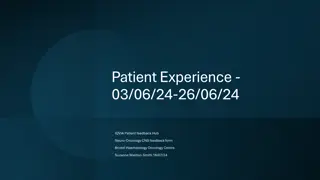Understanding U.S. Health Care System Basics in Oncology Patient Navigation Training
This module delves into the fundamentals of health care navigation with a focus on oncology patients. It covers the core competencies for patient navigators, compares hospital structures, explores cancer care delivery methods, discusses inpatient and outpatient care, and highlights different types of care provided in the health care system.
- Health Care System
- Oncology Patient Navigation
- Hospital Structures
- Cancer Care Delivery
- Inpatient Care
Download Presentation

Please find below an Image/Link to download the presentation.
The content on the website is provided AS IS for your information and personal use only. It may not be sold, licensed, or shared on other websites without obtaining consent from the author. Download presentation by click this link. If you encounter any issues during the download, it is possible that the publisher has removed the file from their server.
E N D
Presentation Transcript
Lesson 5: U.S. Health Care System Module 3: The Basics of Health Care Oncology Patient Navigation Training: The Fundamentals
Acknowledgments This work was supported by Cooperative Agreement #1U38DP004972-02 from the Centers for Disease Control and Prevention. Its contents are solely the responsibility of the authors and do not necessarily represent the official views of the Centers for Disease Control and Prevention. Portions of this lesson are adapted with the permission from the Patient Navigator Training Collaborative of the Colorado School of Public Health.
Competency This lesson covers the following Core Competencies for Patient Navigators: 2.4 Demonstrate basic knowledge of health system operations
Learning Objectives Compare hospital structures (public, non- profit, private) Describe how cancer care may be structured and delivered Compare inpatient and outpatient care delivery Discuss types of care and types of health professionals involved in different types of care
Hospital Systems Non-profit hospitals Public Hospitals Private Hospitals
Cancer Care Delivery Hospital-based programs Academic cancer center Community cancer center Private practice Simone, 2002
Inpatient and Outpatient Care Delivery A hospital patient who receives lodging and food as well as treatment Inpatient A patient who is not hospitalized overnight but who visits a hospital, clinic, or associated facility for diagnosis or treatment Outpatient
Types of Care Specialty Care Emergency Care Urgent Care Primary Care Involves diagnosing and treating life- threatening illnesses or injuries that need immediate attention Care for a patient who has a health problem or illness that requires special knowledge in one medical area Not life- Primary care should be the first place patients go for medical care threatening, but is care for an illness or injury that needs immediate attention
Types of Care Mental Health Care Long-term Care Hospice Care Long-term care is for someone who is not able to perform daily living activities Focuses on care to ease symptoms rather than cure a disease toward the end of life Can help when patients need help with a mental illness or emotional crisis
Primary Care Primary Care Specialists
Oncology Specialists Radiation Oncology Radiology Pathology Hematology/ Oncology Surgery
Emergency Medical concerns include: Chest pain Difficulty breathing Heart attack Serious injury Bleeding that will not stop Mental crisis Higher fevers seizures Department of Health and Human Services, 2009
Checkpoint True or false? Emergency care must be provided to those who need it regardless of ability to pay.
Emergency Care Emergency Medical Treatment and Active Labor Act (EMTALA)
Urgent Care Urgent care needs: Minor cuts and burns Stomachaches Sprains Ear or throat infections
Long-Term Care Person s Home Long-Term Care Facility Assisted Living Facility Long- Term Care
Hospice Care A Hospice Care Facility Person s Home Hospice Care
MentalHealthProfessionals Psychiatrists Counselors Psychologists Licensed Clinical Social Workers
Cancer Care Teams Cancer care is a team effort. Each health care provider is a member of the team with a special role. Some team members are doctors or technicians who help diagnose disease. Others are experts who treat disease or care for patients' physical and emotional needs.
Doctors Primary Care Doctors Specialists
Mid-Level Providers Physician Assistants Nurse Practitioners
Nurses Licensed Practical Nurse (LPN) Registered Nurse (RN) Advanced Practice Nurse (APRN)
Pharmacists Give medicines that are prescribed by a doctor Talk about how to use medicines Answer questions
Technologists and Technicians Laboratory Technologists Look for bacteria or parasites, analyze chemicals, match blood for transfusions or test for drug levels in the blood to see how a patient is responding to treatment. Radiology Technologists Take x-rays, and perform CT (Computed Tomography) scans, MRIs (Magnetic Resonance Imaging) or mammography. Pharmacy Technicians Prepare prescription medications, perform customer service and perform administrative duties.
Therapists and Rehabilitation Specialists Occupational Therapists Work with patients who have physical, mental or developmental disabilities Physical Therapists Test patient s strength and ability to move and create a treatment plan Respiratory Therapists Treat and care for patients with breathing problems Speech Therapists Work with patients who have problems related to speech, communication or swallowing Patient Navigator Training Collaborative, n.d.
Emotional, Social and Spiritual Support Mental Health Professionals Clergy Psychiatrist Psychologist Social Worker Counselor One study found that nearly 90% of hospitalized, seriously ill patients, religion helped them cope. Patients in other studies have indicated that religious belief and practice helped prevent depression. Clergy as Healthcare Providers, n.d.
Patient Navigators Assist patients in accessing cancer care and navigating health care systems Assess barriers to care Engage patients in creating solutions Identify resources Educate patients about what to expect Empower patients to communicate Follow up with patients to support adherence GW Cancer Center, 2014
Administrative and Support Staff Administrative and Clerical Staff Administrative Medical Staff Medical Records Specialists Medical Billing Specialists Financial Counselor Scheduler Volunteers
A Simple Visit When patients visit their provider, the visit involves many more people than just the doctor. Here's an example of health care professionals involved in a simple visit.
Conclusion In this lesson you learned to: Compare hospital structures Describe how cancer care may be structured and delivered Compare in-patient and outpatient care delivery Discuss types of care and types of health professionals involved in different types of care
References Centers for Medicare & Medicaid Services. (2012). Emergency Medical Treatment & Labor Act (EMTALA). https://www.cms.gov/Regulations and Guidance/Legislation/EMTALA/index.html?redirect=/EMTALA/. Weaver, A. J. (2005). Clergy as Health Care Providers. Southern Medical Journal, 98(12):1237. Patient Navigator Training Collaborative. Retrieved April 15, 2021, from: http://patientnavigatortraining.org/. Pratt Chapman, M. L., Willis, L. A., & Masselink, L. (2014). Core competencies for non clinically licensed patient navigators. The George Washington University Cancer Institute Center for the Advancement of Cancer Survivorship, Navigation and Policy: Washington DC. Simone, J. (2002). Understanding cancer centers. Journal of Clinical Oncology, 20(23):4503 4507. doi: 10.1200/JCO.2002.07.574.
Thank you! Follow us on Twitter: @GWCancer www.gwcancercenter.org Sign-up for the GW Cancer Center s Patient Navigation and Survivorship E-Newsletter: bit.ly/PNSurvEnews Sign-up for the GW Cancer Center s Cancer Control Technical Assistance E-Newsletter: bit.ly/TAPenews
